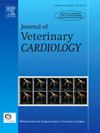经股静脉入路肺动脉瓣球囊成形术治疗体重1.2公斤的犬
IF 1.3
2区 农林科学
Q2 VETERINARY SCIENCES
引用次数: 0
摘要
一个10个月大,1.2公斤,未绝育的雌性马尔他犬以心脏杂音为主诉。超声心动图显示经肺速度5.28 m/s(估计压力梯度:112 mmHg)和严重的肺动脉瓣狭窄,估计肺动脉瓣环直径为7.2 mm。考虑到狗的小尺寸,考虑通过股静脉球囊肺动脉瓣成形术。使用10mm球囊(球囊与肺环之比:1.39)扩张肺动脉瓣环三次。球囊肺动脉瓣成形术后,右心室收缩压从125 mmHg降至78 mmHg。介入手术顺利完成,无严重并发症。术后第149天,最大经肺速度降至2.43 m/s(估计压力梯度为24 mmHg),无肺瓣狭窄复发,临床情况良好。总之,这只1.2公斤的狗通过股静脉入路手术成功,没有明显的并发症。本文章由计算机程序翻译,如有差异,请以英文原文为准。
Transfemoral vein approach for balloon pulmonary valvuloplasty in a 1.2- kg dog
A 10-month-old, 1.2- kg, unspayed female Maltese dog presented with the chief complaint of a heart murmur. Echocardiography revealed a transpulmonary velocity of 5.28 m/s (estimated pressure gradient: 112 mmHg) and severe pulmonary valve stenosis with an estimated pulmonary valve annulus diameter of 7.2 mm. Given the dog's small size, a balloon pulmonary valvuloplasty via the femoral vein was considered. The pulmonary valve annulus was dilated thrice using a 10-mm balloon (balloon-to-annulus ratio: 1.39). After the balloon pulmonary valvuloplasty, right ventricular systolic pressure decreased from 125 to 78 mmHg. The interventional procedure was completed without serious complications. As of postoperative day 149, the maximum transpulmonary velocity decreased to 2.43 m/s (estimated pressure gradient: 24 mmHg), recurrence of pulmonary valve stenosis was not observed, and the patient was doing well clinically. In conclusion, an approach performed via the femoral vein in this 1.2-kg dog resulted in a successful procedure without significant complications.
求助全文
通过发布文献求助,成功后即可免费获取论文全文。
去求助
来源期刊

Journal of Veterinary Cardiology
VETERINARY SCIENCES-
CiteScore
2.50
自引率
25.00%
发文量
66
审稿时长
154 days
期刊介绍:
The mission of the Journal of Veterinary Cardiology is to publish peer-reviewed reports of the highest quality that promote greater understanding of cardiovascular disease, and enhance the health and well being of animals and humans. The Journal of Veterinary Cardiology publishes original contributions involving research and clinical practice that include prospective and retrospective studies, clinical trials, epidemiology, observational studies, and advances in applied and basic research.
The Journal invites submission of original manuscripts. Specific content areas of interest include heart failure, arrhythmias, congenital heart disease, cardiovascular medicine, surgery, hypertension, health outcomes research, diagnostic imaging, interventional techniques, genetics, molecular cardiology, and cardiovascular pathology, pharmacology, and toxicology.
 求助内容:
求助内容: 应助结果提醒方式:
应助结果提醒方式:


